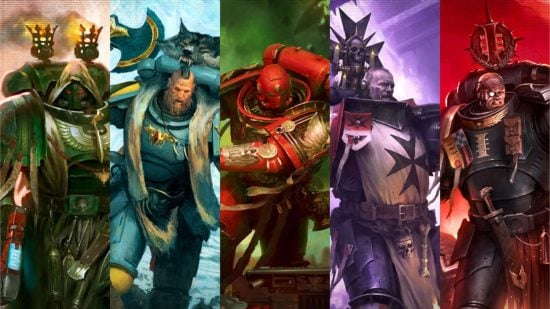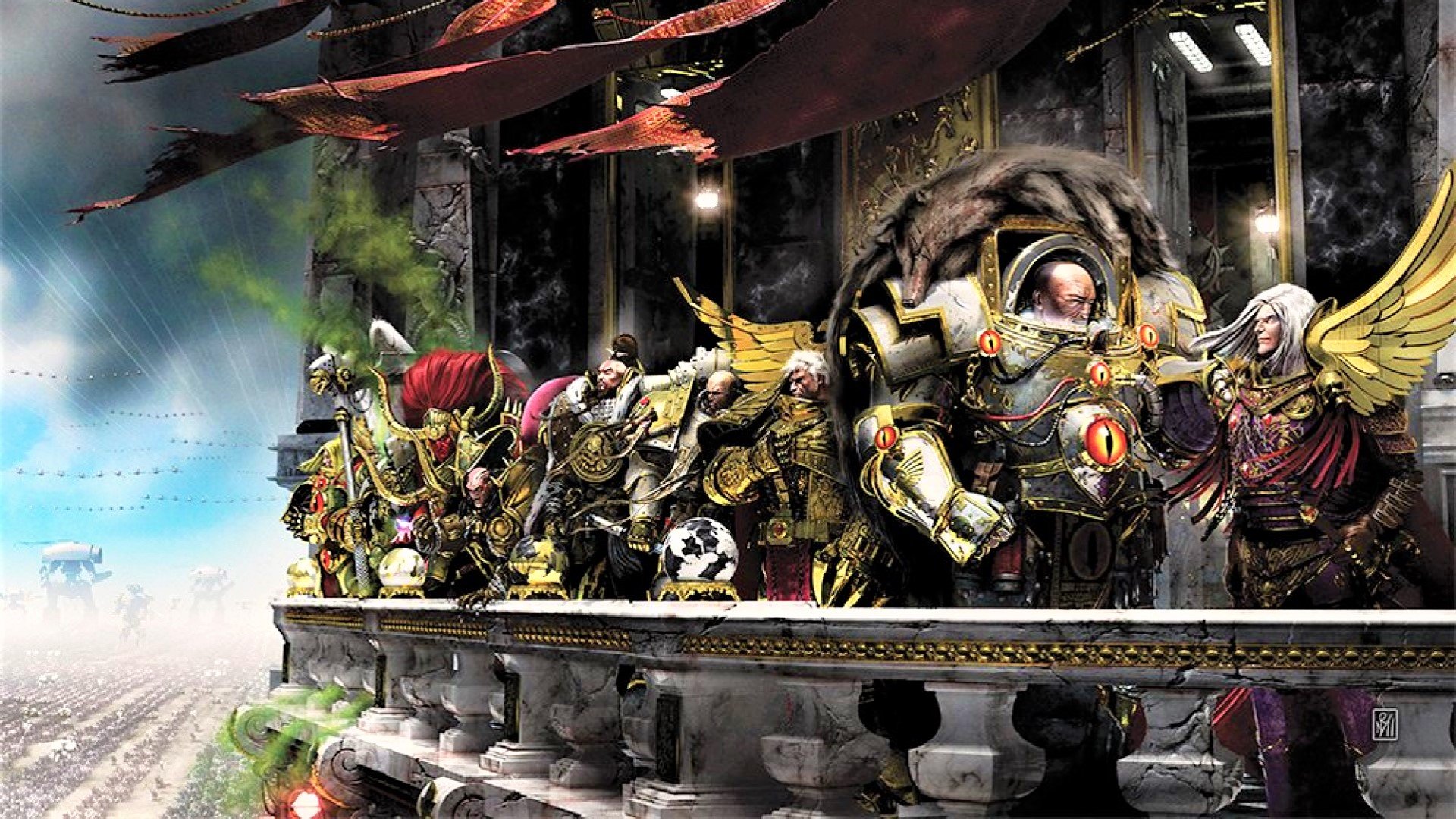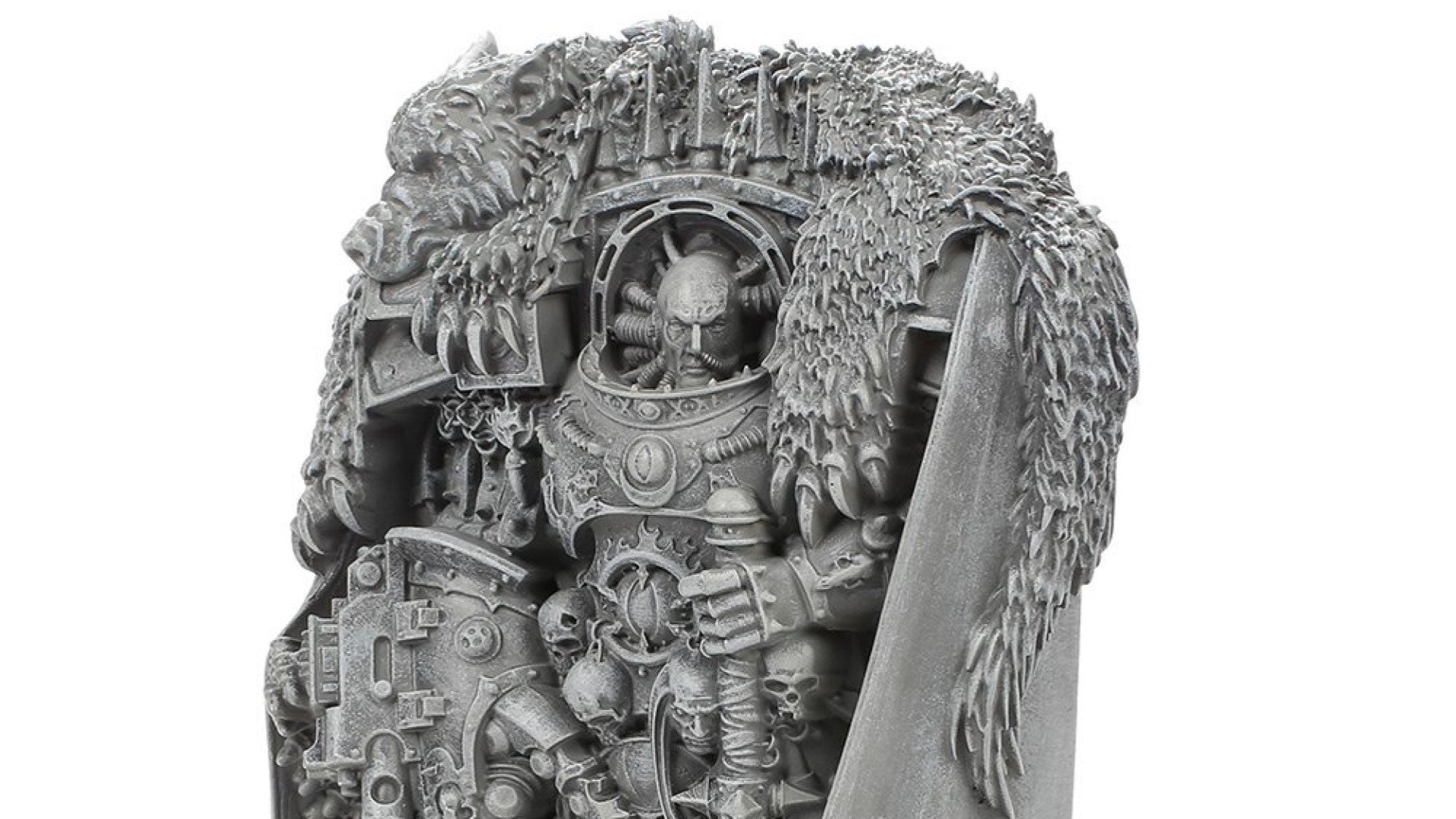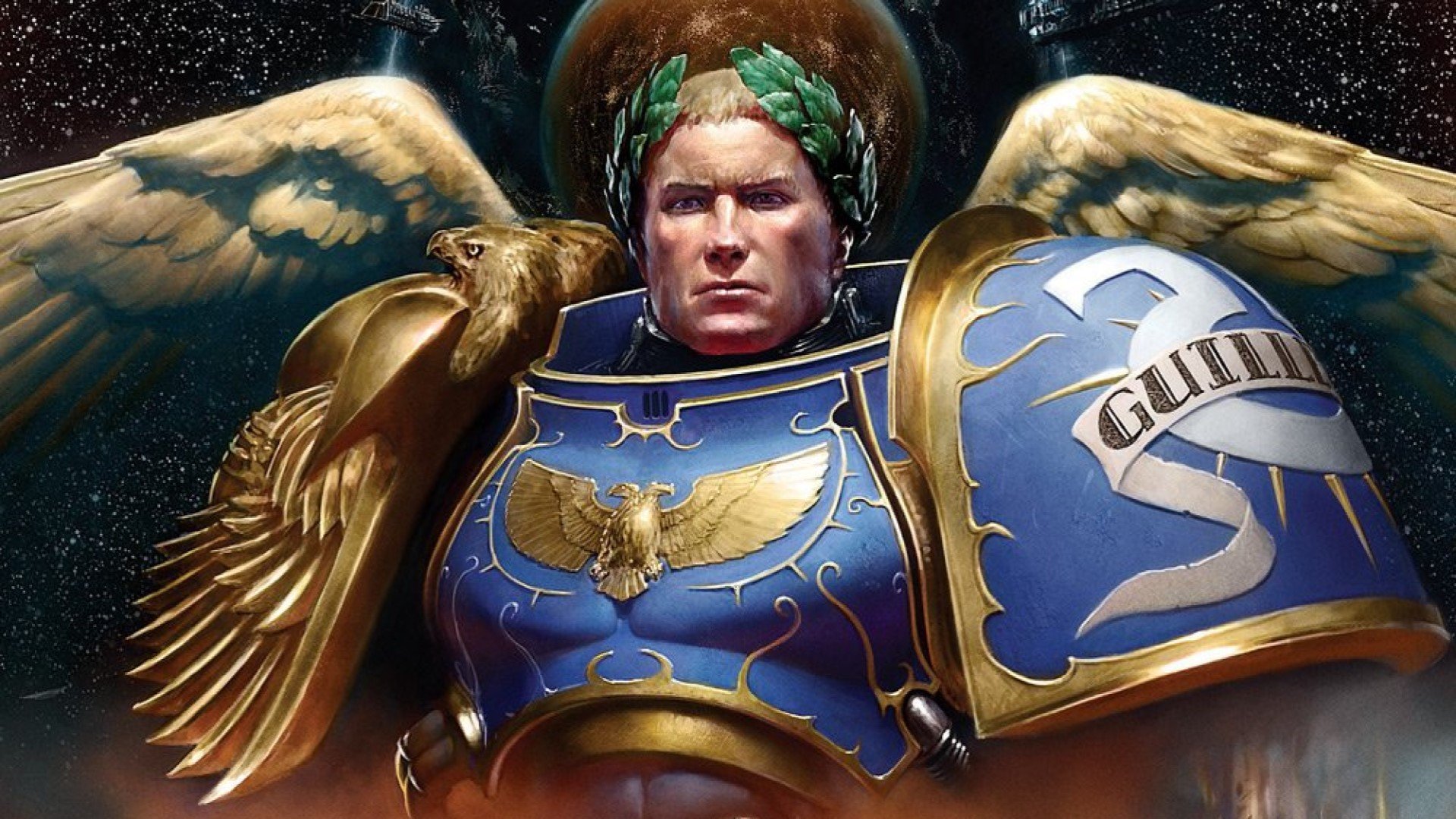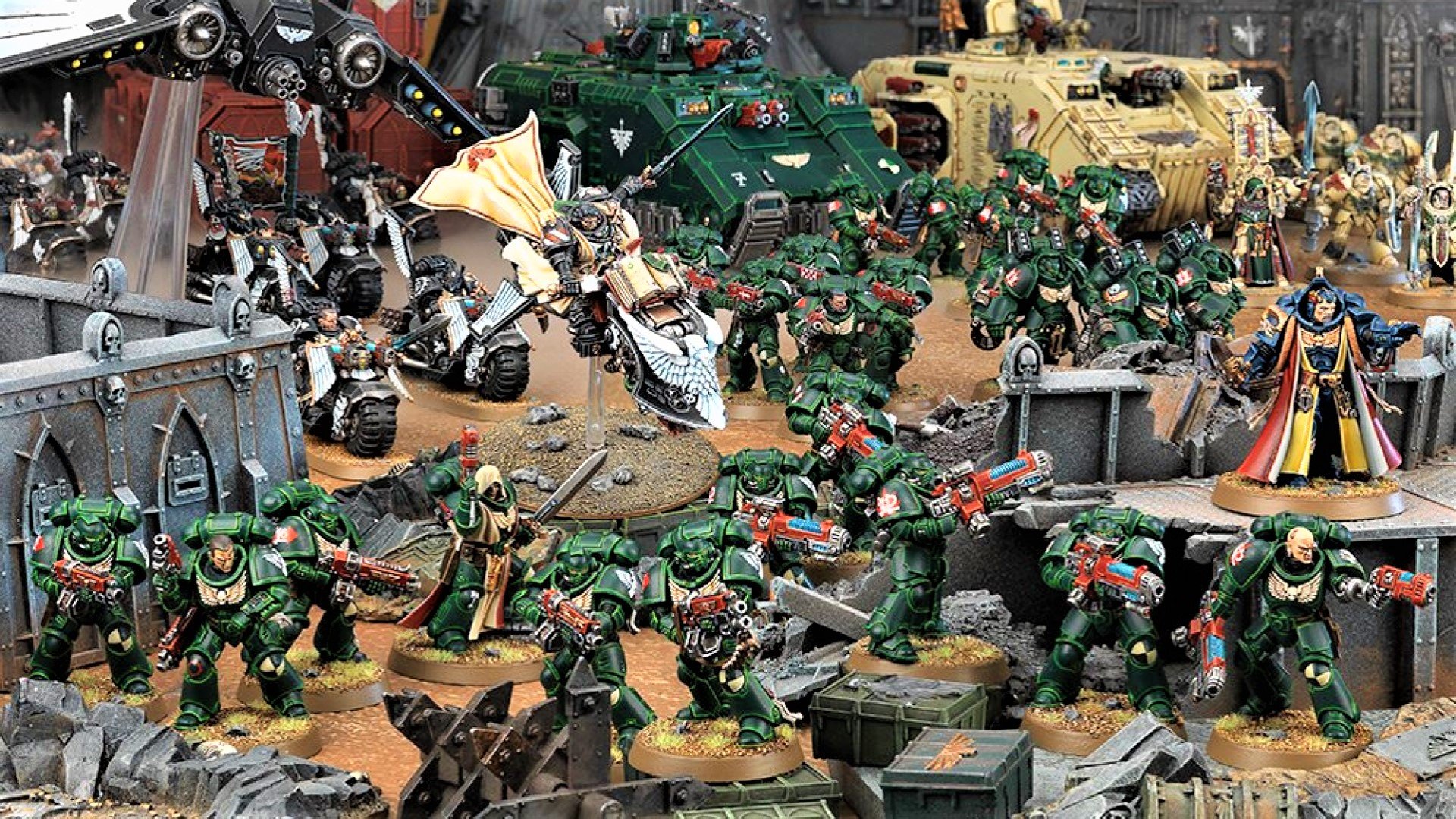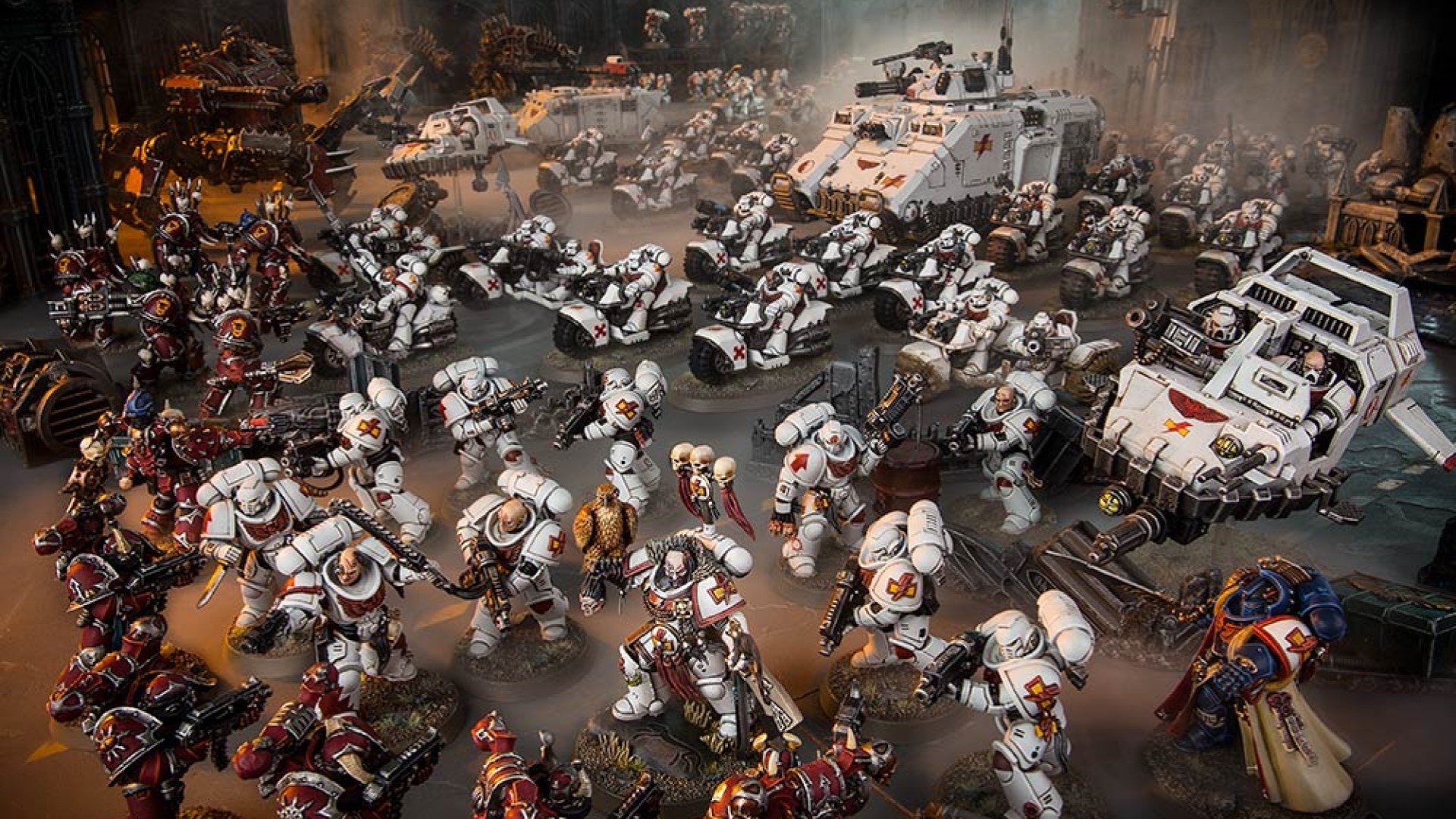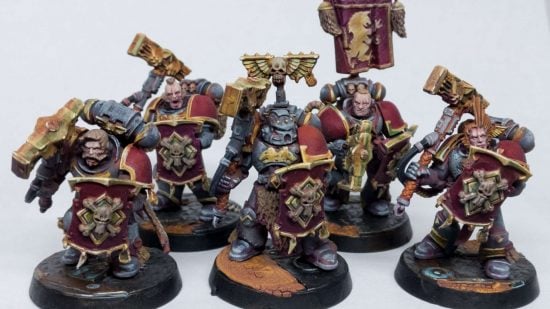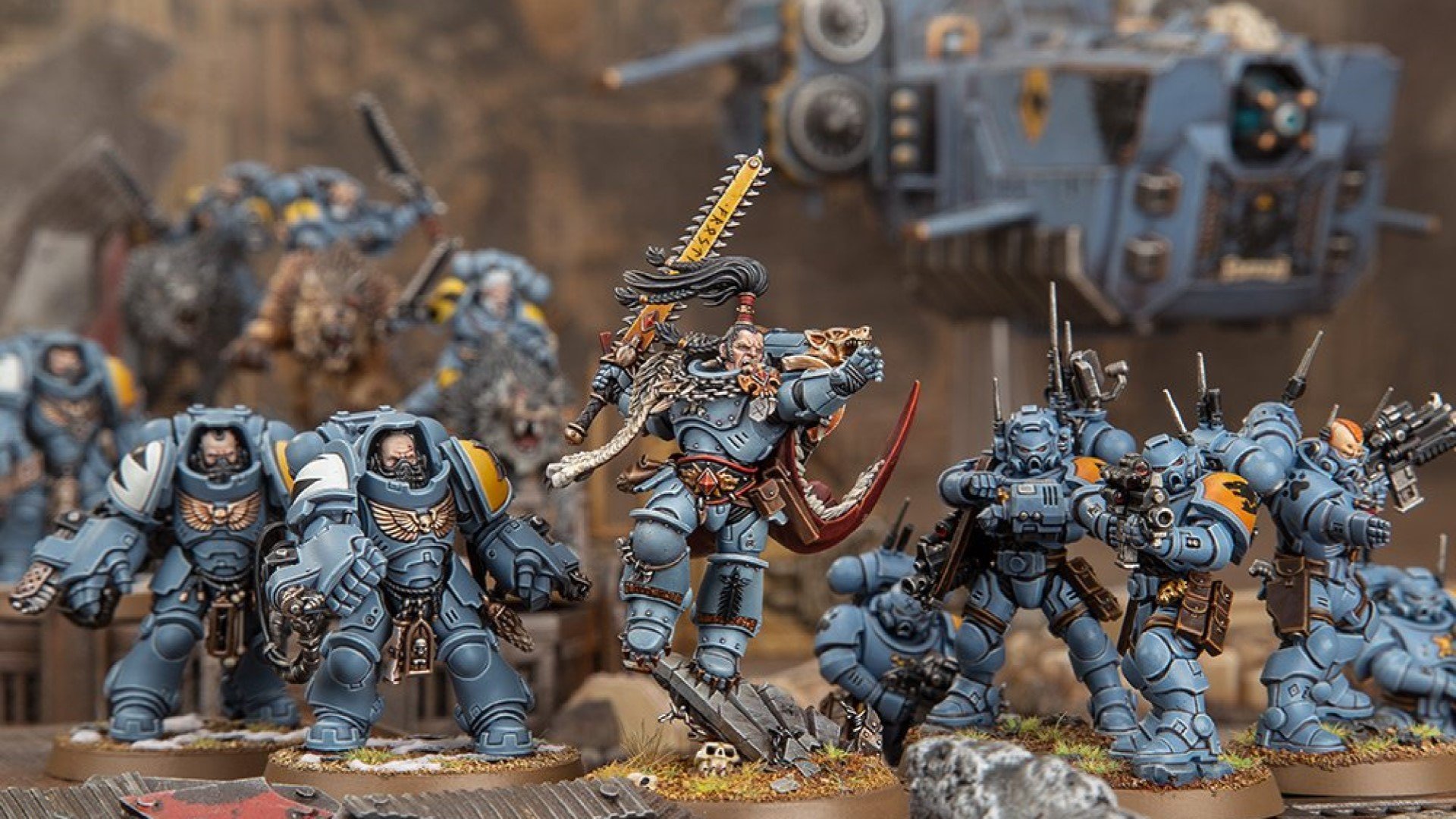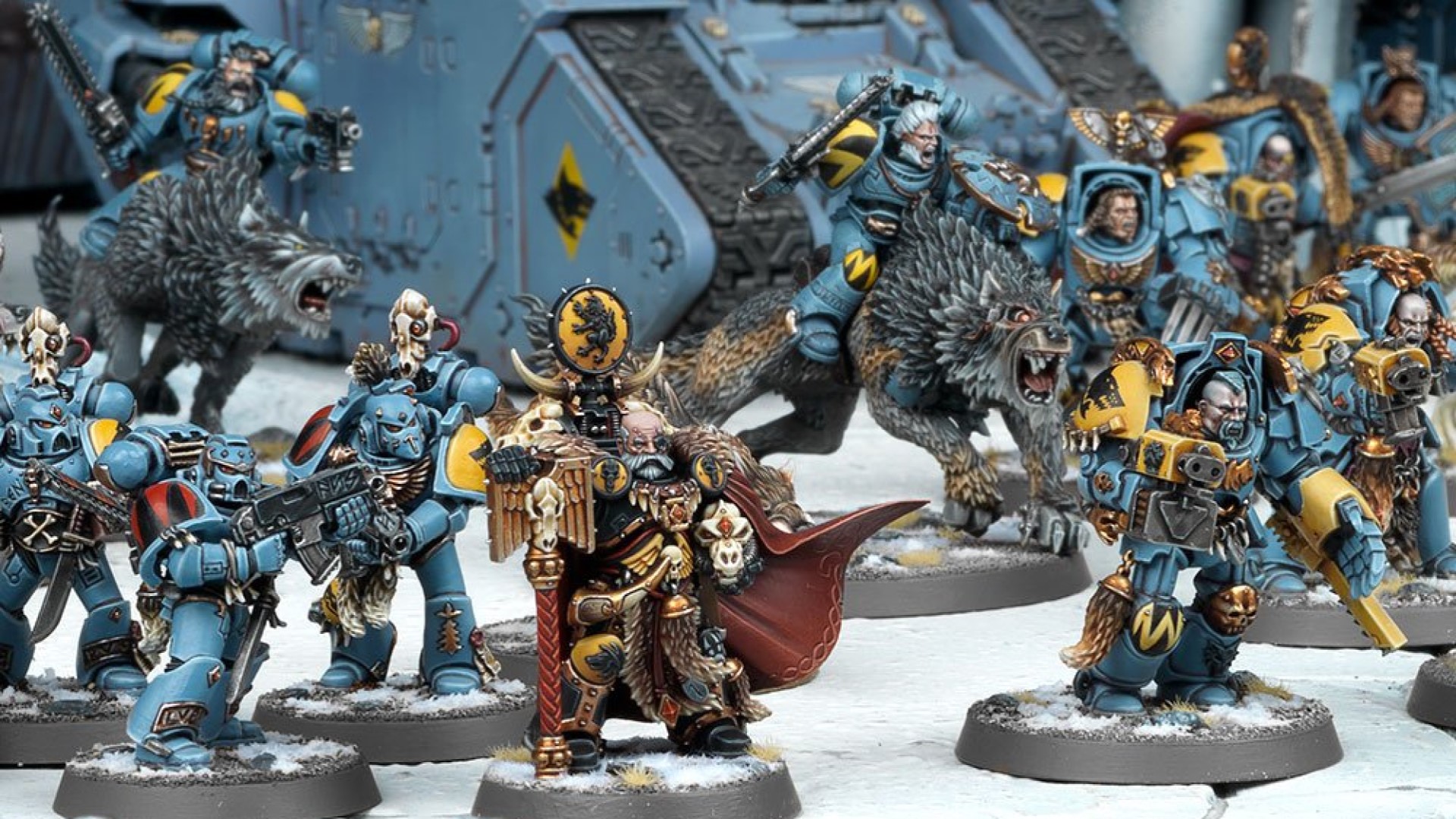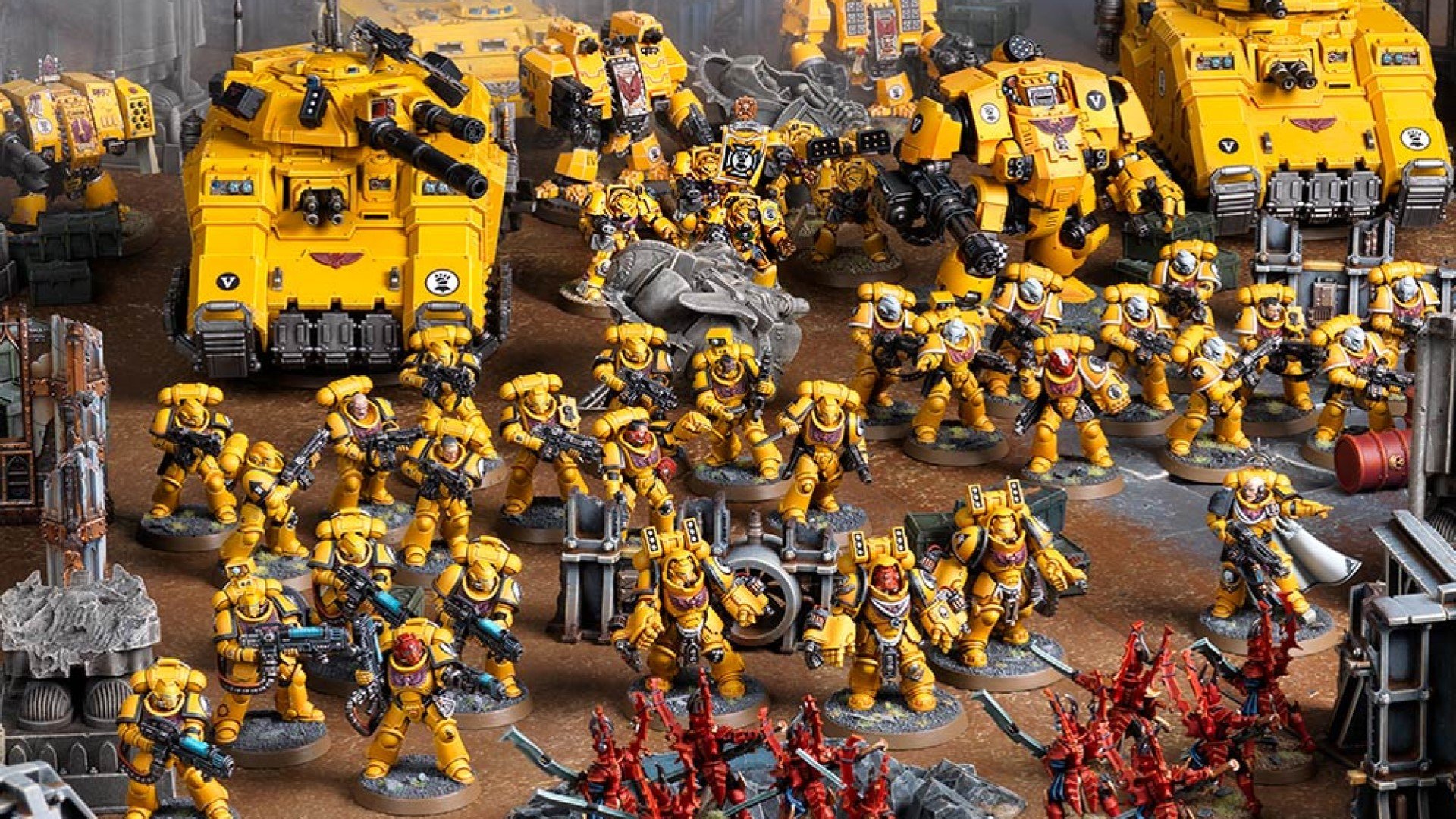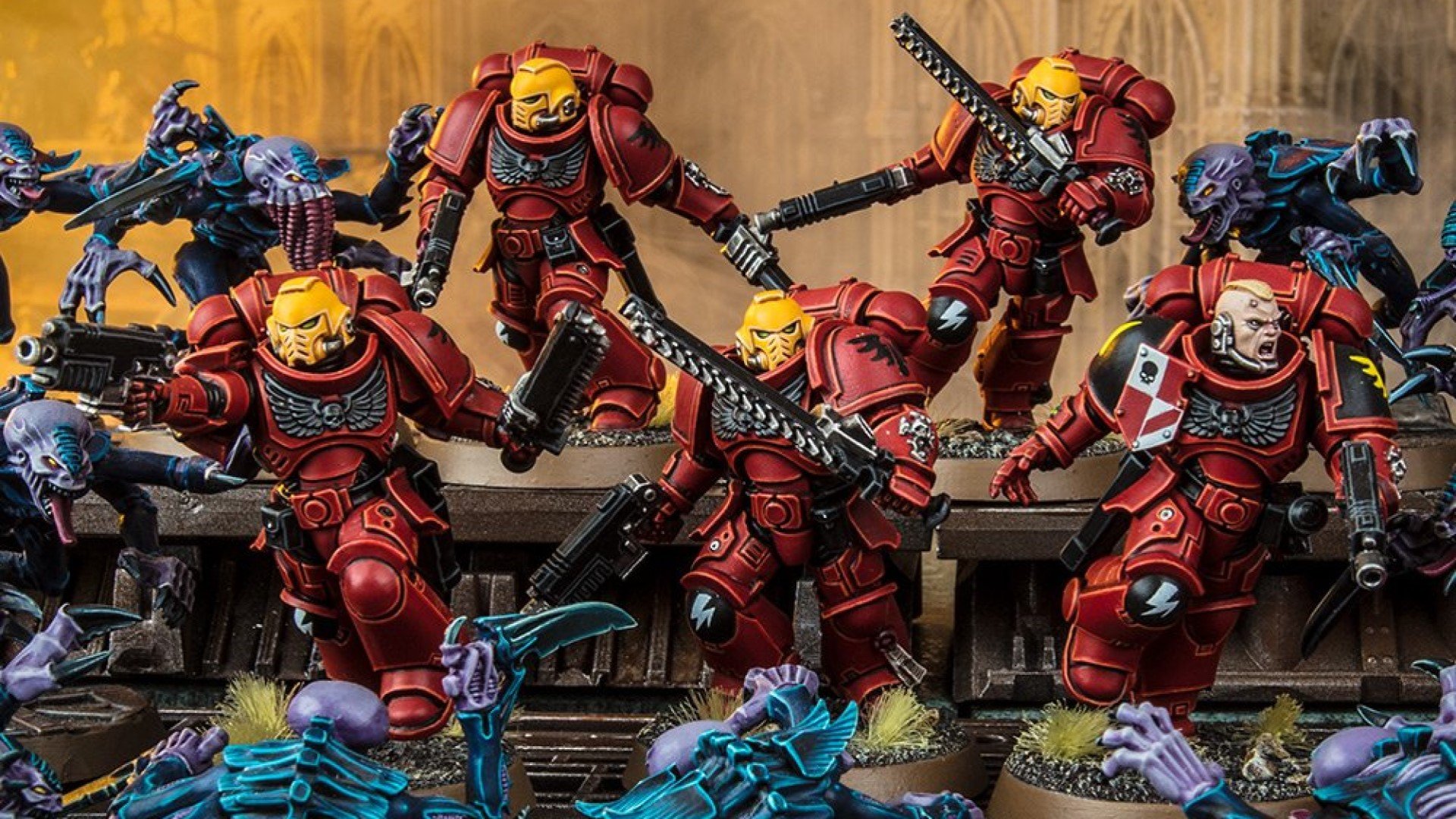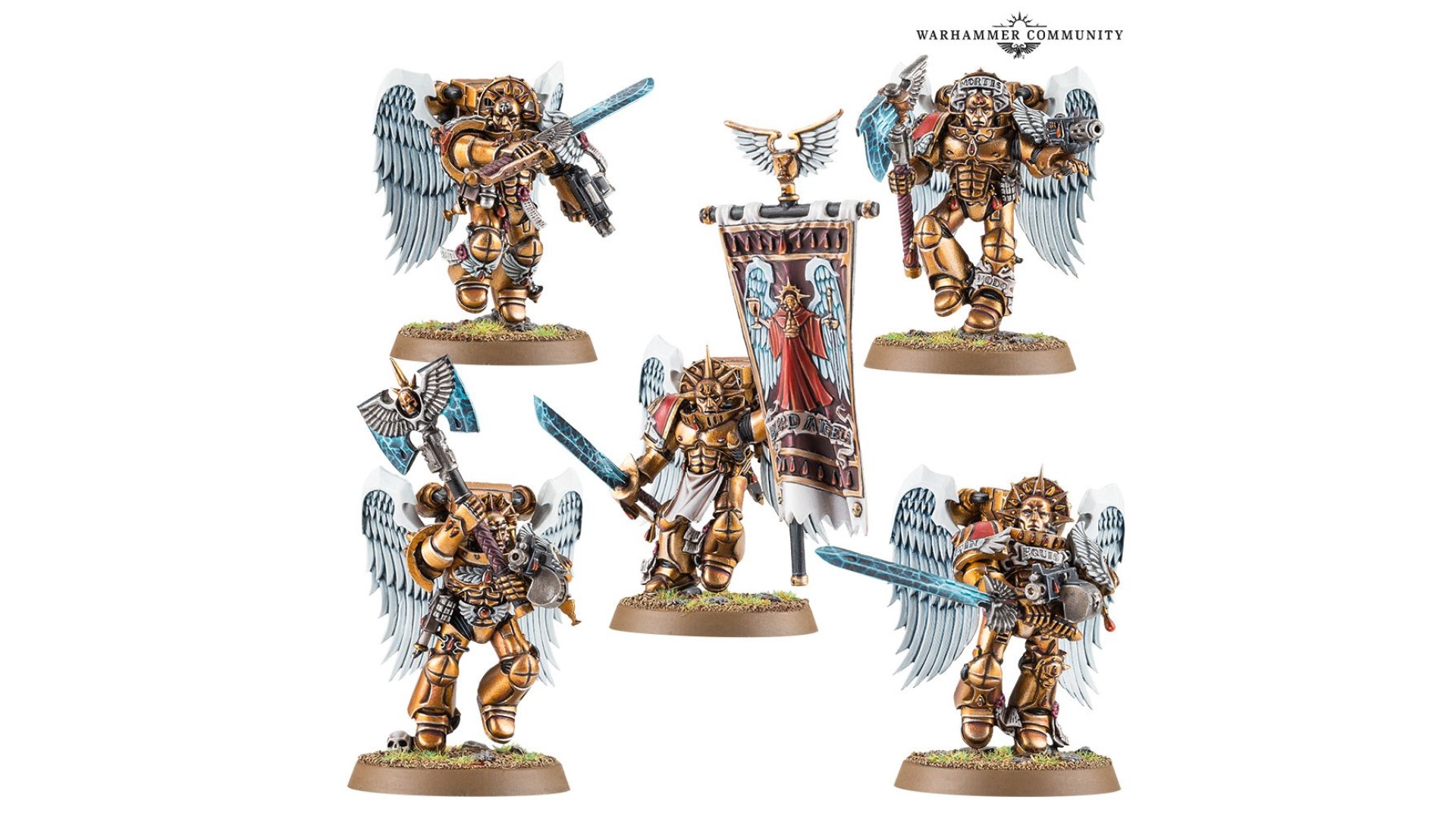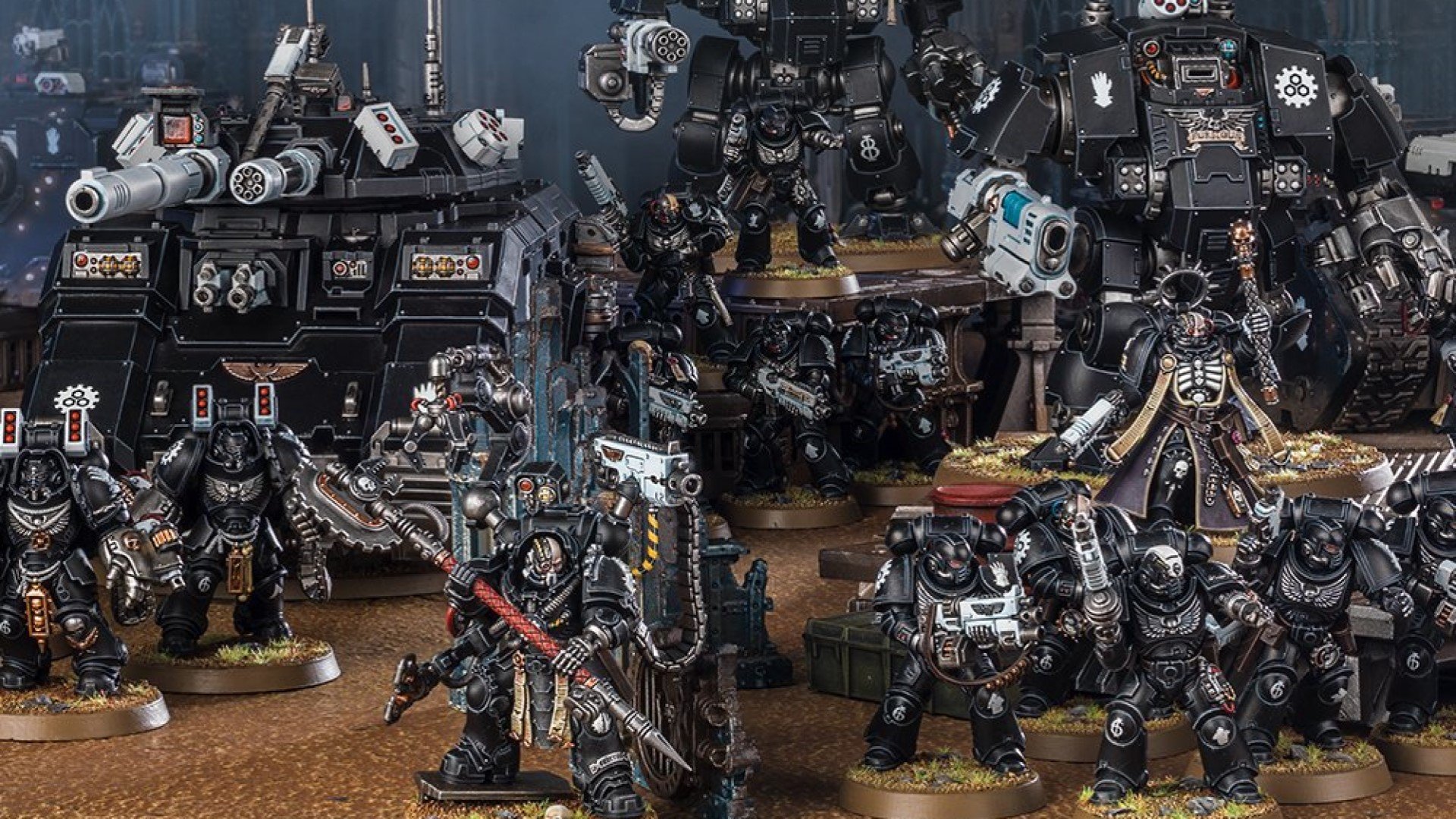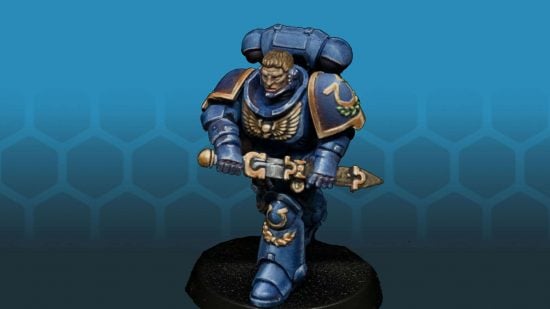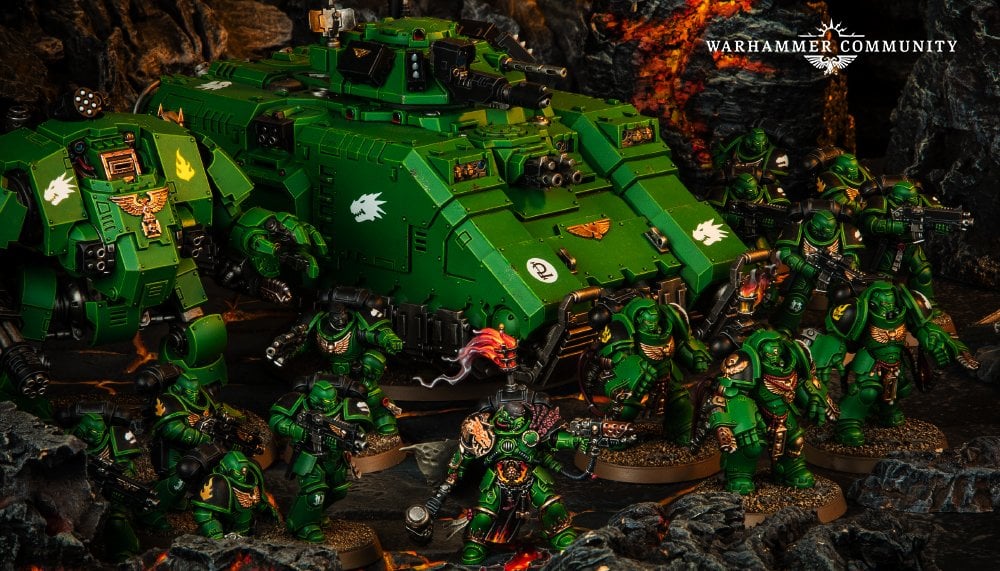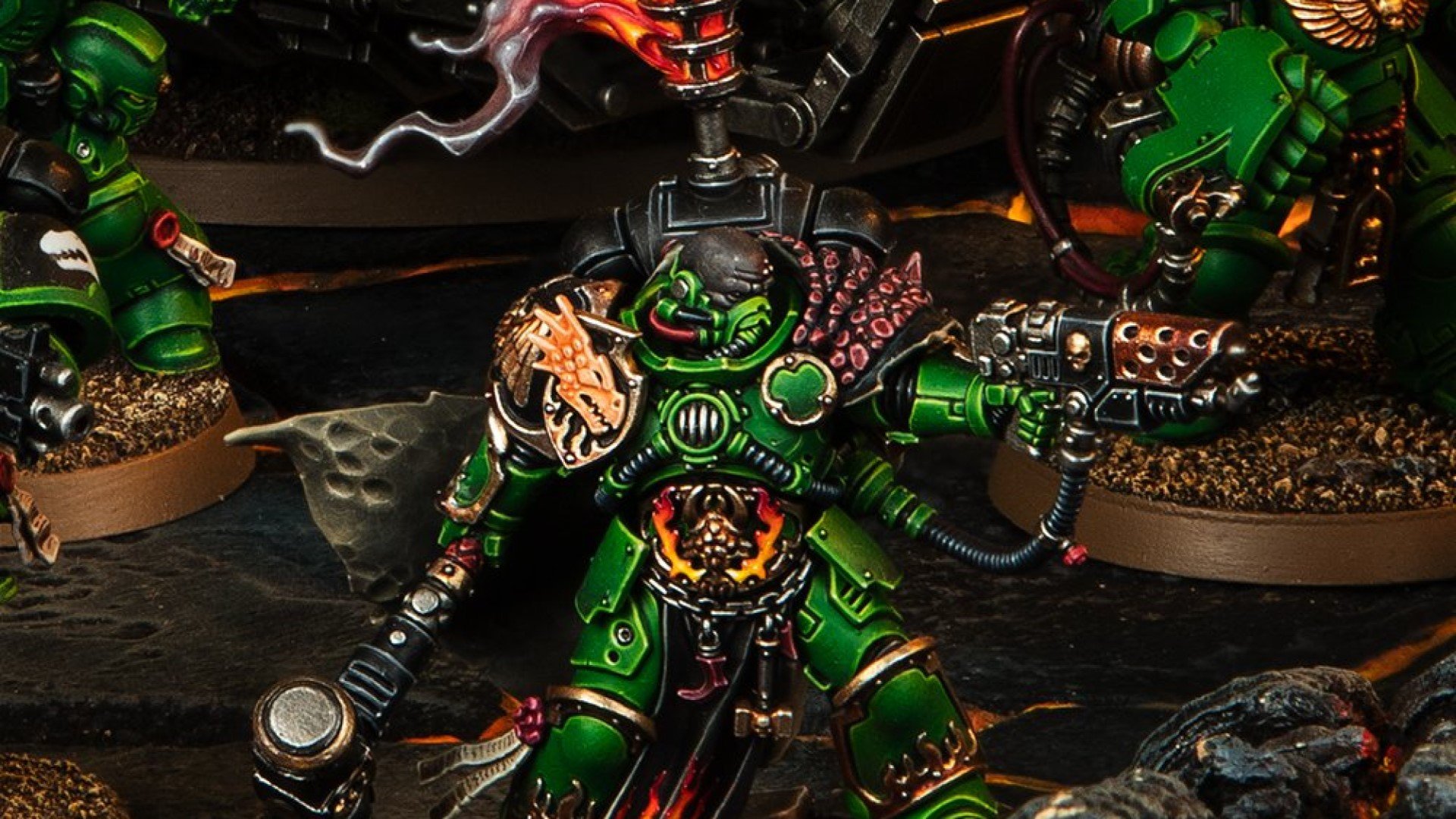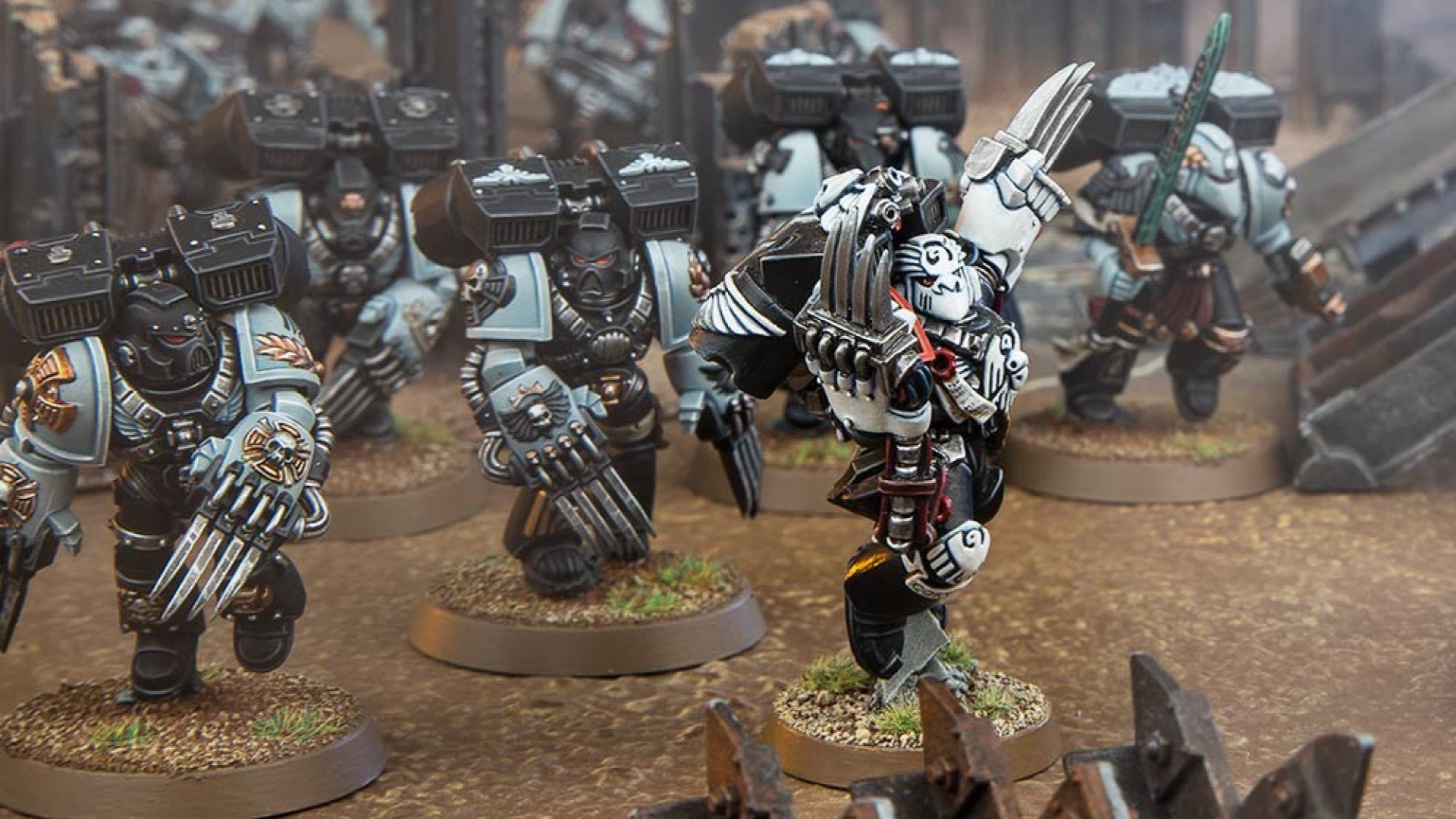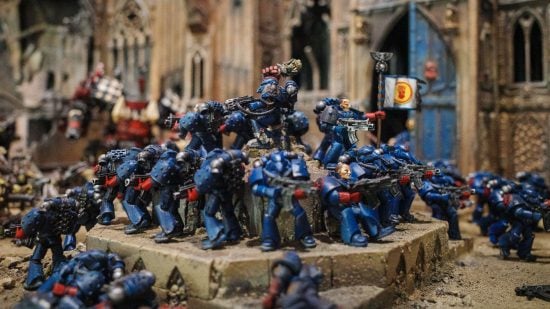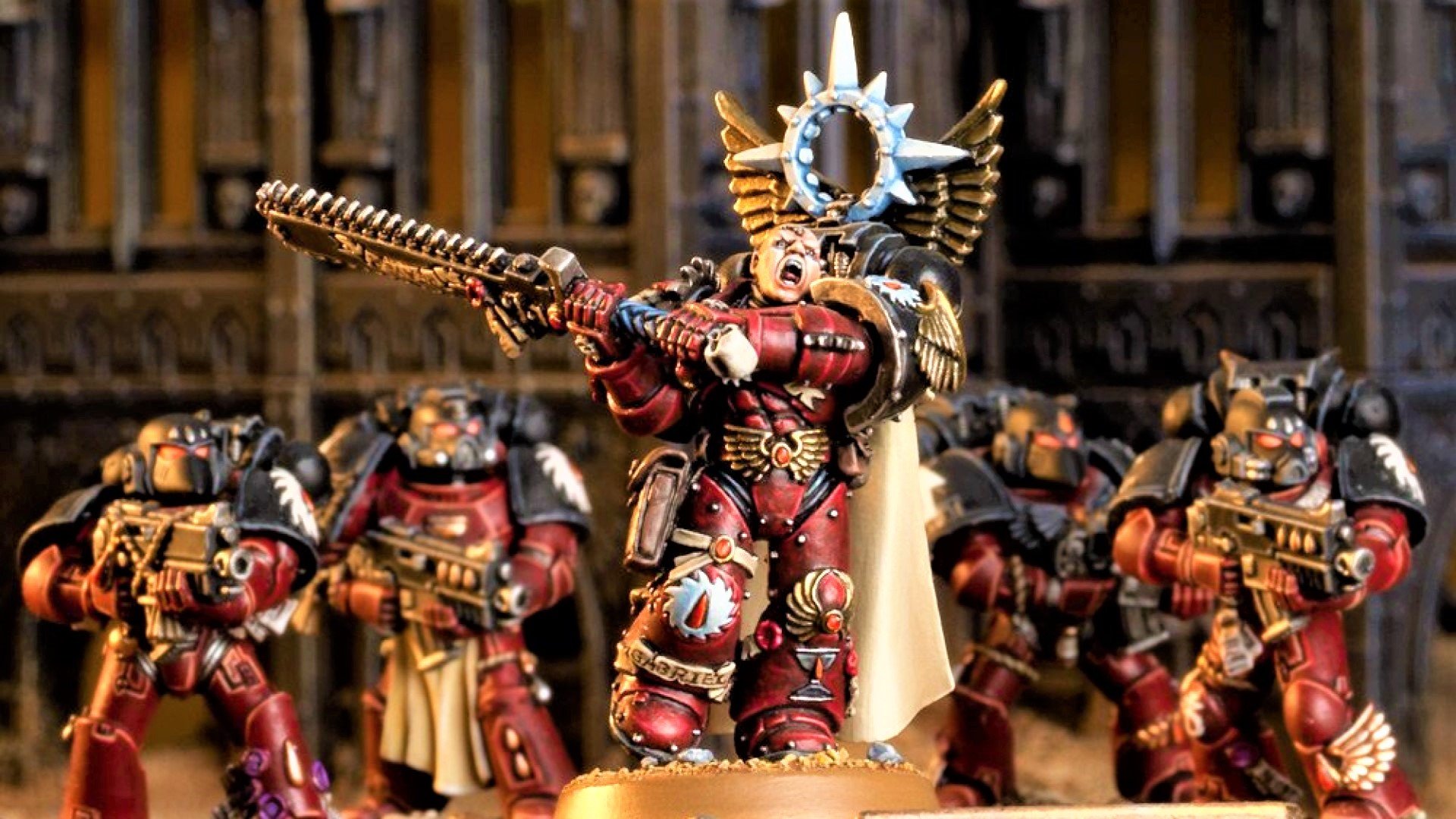There are said to be 1,000 Warhammer 40k Space Marine Chapters within the Imperium of Man, each tracing its origin back to the nine loyal Space Marine Legions that stood beside the Emperor of Mankind during the Horus Heresy.
We have a separate guide to Space Marines that explains what they are, and how they play on the tabletop. Or if you’d prefer to learn about armies with a little less power armor, we have guides to all the other Warhammer 40k factions.
This guide covers the most important chapters – those that bear the names of the lost legions, and their most famous successors. It introduces their character and history, as well as pointing you towards our full-fat guides to each chapter.
Here’s everything you need to know about how the Warhammer 40k Space Marine Chapters came to be.
Space Marine legions
In 40k lore, the Space Marine legions were the first organised armies of Adeptus Astartes warriors – formed and blooded in the 31st millennium – ten millennia before the setting’s ‘present day’.
The Emperor of Mankind created 20 vast legions of transhuman marines – the Legiones Astartes – using a combination of his own genius, and the work of many genetic scientists (chief among them Amar Astarte, after whom the resulting warriors were named). They were intended to be the spearhead of a Great Crusade that would reconquer all the domains of mankind across the galaxy.
Each legion was many thousands strong, and each was bred exclusively from the genetic material of one of the Imperium’s extraordinary Primarchs: uniquely advanced primogenitor marines made from the Emperor’s own genetic code, each of whom acted as a crusading general at the head of his allotted legion.
The Primarchs and their legions fought alongside one another for many years in the Great Crusade, successfully expanding the Imperium far and wide throughout our galaxy – latterly under the leadership of Horus Lupercal, Primarch of the XVI Legion, named ‘Warmaster’ by the Emperor himself.
Then, tragically, nefarious Warhammer 40k Chaos forces intervened. Several times.
Thanks largely to cunning schemes laid by Chaplain Erebus of the Word Bearers legion, Horus Lupercal defected to the service of the Chaos gods. His civil uprising against the Emperor’s rule was later known as the Horus Heresy.
From the Heresy’s initial, devastating ambushes at Istvaan III and V -and for all time thereafter – the 18 Space Marine legions were split by Imperial historians into two camps: they were loyalists, or they were traitors.
| Legion | Primarch | Allegiance |
| I Legion – Dark Angels | Lion El’Jonson | Loyalist |
| II Legion – REDACTED | REDACTED | REDACTED |
| III Legion – Emperor’s Children | Fulgrim | Traitor |
| IV Legion – Iron Warriors | Perturabo | Traitor |
| V Legion – White Scars | Jaghatai Khan | Loyalist |
| VI Legion – Space Wolves | Leman Russ | Loyalist |
| VII Legion – Imperial Fists | Rogal Dorn | Loyalist |
| VIII Legion – Night Lords | Konrad Curze | Traitor |
| IX Legion – Blood Angels | Sanguinius | Loyalist |
| X Legion – Iron Hands | Ferrus Manus | Loyalist |
| XI Legion – REDACTED | REDACTED | REDACTED |
| XII Legion – World Eaters | Angron | Traitor |
| XIII Legion – Ultramarines | Roboute Guilliman | Loyalist |
| XIV Legion – Death Guard | Mortarion | Traitor |
| XV Legion – Thousand Sons | Magnus the Red | Traitor |
| XVI Legion – Luna Wolves / Sons of Horus | Horus Lupercal | Traitor |
| XVII Legion – Word Bearers | Lorgar | Traitor |
| XVIII Legion – Salamanders | Vulkan | Loyalist |
| XIX Legion – Raven Guard | Corvus Corax | Loyalist |
| XX Legion – Alpha Legion | Alpharius and Omegon | Traitor |
We’re going to give you a bit of a spoiler here: the loyalists won. The Emperor killed Horus aboard the Warmaster’s attacking flagship, the Vengeful Spirit; the traitor forces splintered and fled; and the loyalists chased the routed remainders of the invading fleet right into the dreaded Eye of Terror. If you want to know what happened to them, read our guide to Warhammer 40k’s Chaos Space Marines.
In 2022 Games Workshop launched an accessible second edition of the Warhammer: The Horus Heresy tabletop wargame with the massive Age of Darkness box set, so you can now collect and lead your own Heresy-era Space Marine legions.
For now, though, we’re interested in what happened next for the Space Marines who remained loyal to the Imperium of Man.
Space Marine chapters
With the traitor Warmaster dead and Emperor of Man enshrined in living death upon the Golden Throne, Ultramarines Primarch Roboute Guilliman took the reigns of Imperial governance. To ensure that no one person could ever again command the might of a Space Marine legion, Guilliman began the reforms that created the Space Marine chapters.
In a decree titled the Codex Astartes, Guilliman ordered that the legions be split into Chapters of exactly 1,000 Space Marines, guided by prescribed codes of combat. This event, called the Second Founding, created new ‘successor’ chapters, each adopting their own colors, iconography, and home world, while the so-called “First-founding Chapters” retain the colors and livery of their parent legion.
10,000 years later, in the 41st millennium, there are thousands of Space Marine chapters active across the galaxy. Subsequent foundings have raised new Chapters, and the Ultima founding – initiated in secret by Belisarius Cawl – has added many brotherhoods of mighty Primaris Marines.
Some follow Guilliman’s edicts in the Codex Astartes all these millennia later – others, not so much – and all but the lucky Ultramarines and mysterious Dark Angels are now missing their Primarchs.
- Dark Angels
- White Scars
- Space Wolves
- Imperial Fists
- Blood Angels
- Iron Hands
- Ultramarines
- Salamanders
- Raven Guard
Dark Angels
The former I Legion Astartes, the stern, secretive Dark Angels hail from the forest planet of Caliban. Or rather, the remains of the planet Caliban – the world itself was destroyed, but the Dark Angels chapter still sails the void in a huge spacecraft built from a fragment of the dead planet, which they call The Rock.
During the Horus Heresy, a large portion of the Dark Angels legion turned to Chaos, leading to a huge, ultraviolent confrontation that saw the loyalist side victorious (but decimated), the planet Caliban itself shattered to bits, and the surviving traitor Dark Angels scattered out into the galaxy.
The loyalists have been hunting down these ‘Fallen’ ever since in a quest for absolution for their chapter. In the 41st millennium, as a Codex compliant chapter, the Dark Angels are still on this mission of redemption, with multiple successor chapters aiding them.
In battle, the Dark Angels are all about coordinated strikes from specialised ‘wings’, each used to maximum effect. Ravenwing bikers, land speeders, and flyers harry the foe with fast-moving cavalry charges, while a core of ranged infantry fire off fusillades of plasma fire from drilled battle lines. Then, once enemy lines are weak, the terminator-armored Deathwing knights crash in to finish them off. Dark Angels take some balance to play, but they can be devastating.
If you want to learn more about them, dive into our full Warhammer 40k Dark Angels guide.
Books you need to play Dark Angels
The Dark Angels use units from the free Index Space Marines and Index Dark Angels, which you can download from the Warhammer Community website.
If you want to learn more about the Dark Angels lore, you can find their background in the ninth edition Codex Dark Angels supplement.
Dark Angels Combat Patrol
The Combat Patrol: Dark Angels box contains:
- Primaris Intercessors x 5
- Inceptors x 3
- Redemptor Dreadnought
- Primaris Chaplain
- Dark Angels Primaris upgrade sprues x 2
White Scars
The White Scars – formerly the V Legion Astartes – are renowned as both one of the most popular Space Marine chapters, and one of the hardest to paint. The sons of Primarch Jaghatai Khan, a.k.a. the Warhawk, the White Scars were briefly neutral in the Horus Heresy, before coming down firmly on the side of the Emperor. In the 41st millennium, they’re still going strong, and compliant with the Codex Astartes, counting many successor chapters to their name.
Now, there’s no beating around the bush on this one: these folks are an incredibly on-the-nose sci-fi analogue for the mounted Mongol hordes of Genghis Khan, which conquered most of the (real) world in the 12th century. The language, names, cultural mores, and martial traditions of their home planet, Chogoris – and all who hail from there – are strongly coded around real-world East Asian and Steppe cultures.
While these themes are sometimes used to create exciting fiction and super-cool in-game content, they’re not too subtle, or particularly diligently tied to any real history. Your mileage with this may vary – but it’s something to be aware of.

In battle, the White Scars are all about speed and tactical agility, with rules and abilities that favour swift assaults and sly manoeuvring tricks to outfox enemy defences.
White Scars armies therefore tend to include a lot of bikes, land speeders, and other fast vehicles, as well as troop transports, to get their whole fighting force into the position in record time.
Books you need to play White Scars
You’ll find White Scars lore in the 10th edition Codex Space Marines, plus the eighth Codex White Scars supplement.
Space Wolves
Once the VI Legion Astartes, the lupine sons of Leman Russ – also known as the Emperor’s Executioners, among many, many other names – the Space Wolves command just as much respect and fear in the 41st millennium as they did in the 31st.
Ferocious, instinctive fighters, they channel the spirit of their fearsome, furry namesakes by fighting in packs, and favouring vicious, overwhelming melee combat over big guns, or fancy footwork. It’s worth noting, too, that, in terms of cultural analogues, these guys are to Scandinavia as the White Scars are to Mongolia. Cold weather, Futhark runes, and plaited beards aplenty.
While they are as fiercely loyal to the Emperor as ever, the Space Wolves absolutely do not adhere to Roboute Guilliman’s Codex Astartes. We don’t know exactly how many Space Wolves Space Marines there are in the 41st millennium, but it’s significantly more than 1,000.
And, far from organising marines into ten companies of ten separate ten-marine squads, Space Wolves go to war in Great Companies, made up of many dozens of Wolf Packs, organised by battlefield role and seniority (or a mixture of the two). In short, they do things their own way, to the max.
On the tabletop, this goes double; the Space Wolves have long had custom in-game rules that reflect just how different they are from your standard Space Marine.
A variety of unique, sharp-fanged units, such as Thunderwolf Cavalry, Fenrisian Wolves, and the terrifying Wulfen, combine with powerful close combat buffs and stratagems, to make Space Wolves one of Warhammer 40k’s most powerful melee armies.
Books you need to play Space Wolves
The Space Wolves use units from the free Index Space Wolves and Index Space Marines, available to download from the Warhammer Community website.
You can discover Space Wolves lore in the ninth edition Codex Space Wolves supplement.
Combat Patrol Space Wolves
The Combat Patrol: Space Wolves box set contains:
- Primaris Intercessors x 10
- Invictor Tactical Warsuit
- Invictor Tactical Warsuit
- Primaris Reivers x 5
- Primaris Lieutenant
- Space Wolves Primaris upgrade sprue x 2
Imperial Fists
Originally the VII Legion, led by Primarch Rogal Dorn, the Imperial Fists are mostly famed for two things: their vivid yellow armor, and their prodigious skill at fortification and defence.
Put in charge of the protection of Terra (Earth) and its solar system during the Horus Heresy, the Imperial Fists and their Primarch won many great victories against Horus’ forces in the extended Siege of Terra, and were certainly vital to the loyalists’ survival under the onslaught of Chaos. Now, 10,000 years later, the Imperial Fists still share the reserved, sceptical, and stoic disposition of their blond-haired gene-father.
They follow the Codex Astartes – with a couple of dozen successor chapters to their name – and are based partly on Holy Terra, and partly aboard the Phalanx, Rogal Dorn’s enormous flagship-slash-fortress monastery.

The Fists also retain their historic expertise where fortifications are concerned, boasting a variety of stratagems and custom psychic powers centred around tackling enemies in buildings, and a Chapter Tactic that lets them ignore enemies’ Light Cover when shooting at them – representing the Fists’ unmatched talent at spotting weak points in walls.
The stolid Imperial Fists may not be the most ‘rock n’ roll’ of Space Marine Chapters; nor, usually, are they the most competitively powerful – but their august history and striking colour scheme make them a favorite of many.
Books you need to play Imperial Fists
You can discover more Imperial Fists lore in the the ninth edition Codex Space Marines, plus the eighth edition Codex Imperial Fists supplement.
Blood Angels
Formed from the IX Legion Astartes, the Blood Angels are the gene-sons of the handsome, tragically clairvoyant Primarch Sanguinius, who was killed by his brother Horus Lupercal in the final battle of the Horus Heresy. They are led, in the 41st millennium, by Commander Dante, the oldest living Space Marine.
These scarlet-armored paragons are rightly celebrated as one of the Adeptus Astartes’ most devastating aerial assault forces, and deadly, elegant close-quarters fighters – with a notable streak of altruism and protectiveness over the Imperium’s human citizens that’s often absent in other Space Marine Chapters. But, while nobility and heroism flow through the proud Blood Angels’ veins, so too does their hidden Flaw, a disastrous fault in Sanguinius’ genetic code that lurks within every single Space Marine of the Blood Angels and their Successor Chapters.

The Flaw can manifest in two ways:
The Black Rage
An agonising psychic echo of Sanguinius’ death at Horus’ hands is imprinted into the mind of every Space Marine of his geneseed. At any time – but usually in the midst of battle – this shared genetic memory can overtake them, filling them with all the vengeful fury felt by the Primarch at the moment of his death, and driving the Space Marine’s lesser mind completely insane.
Blood Angels taken over by the Rage are assigned to the Chapter’s infamous Death Company, and deployed where the fighting is thickest, to slake their insatiable anger with the deaths of enemies, before meeting their own end.
The Red Thirst
Buried deep in every Blood Angel’s genetic coding is an instinctive call to violence and bloodshed, which, if embraced and followed to the fullest, leads to an obsession with, and thirst for, the lifeblood of enemies. While the specific effects of the Red Thirst are the Chapter’s most shameful and best-kept secrets – rumours abound that its victims effectively become the vampires of legend, with sharp fangs, pale skin, extended lifespans, and a compulsion to drink living blood.
Still, if you can get over their potentially haemovorous tendencies, the Blood Angels are an ancient, storied, and distinctive Chapter to collect and play on the tabletop, with quite a few unique units to their name, such as the Death Company and Sanguinary Guard – learn more about them in our guide to the Blood Angels.
Books you need to play Blood Angels
Blood Angels use units from the free Index Space Marines and Index Blood Angels that you can download from the Warhammer Community Website.
You can discover more Blood Angels lore in the ninth edition Blood Angels Codex Supplement.
Combat Patrol Blood Angels
The Combat Patrol Blood Angels box set contains:
- Primaris Librarian
- Impulsor
- Primaris Intercessors x 5
- Primaris Incursors x 5
- Primaris Aggressors x 3
- Blood Angels Primaris upgrade sprues x 2
Iron Hands
Formerly known as the X Legion Astartes, the Iron Hands Chapter have a closer affinity with the technology-loving machine cult of the Adeptus Mechanicus than any other Space Marine Chapter, or perhaps any other branch of the Imperium. In battle, they’re renowned for fielding large numbers of tanks, Dreadnoughts, and other war machines, as opposed to massed infantry – and for encouraging augmetic body part replacements (or improvements, depending on your point of view) among their Space Marines.
This tendency towards mechanised warfare and cyborg enhancements is partly an expression of the personality of their dead Primarch, Ferrus Manus, the consummate engineer, who was decapitated by the traitor Primarch Fulgrim in the opening acts of the Horus Heresy.
But it’s also an attempt to ‘engineer out’ their human emotions, to purge their grief and guilt for Ferrus Manus’ death – as well as, originally, a straightforward practical measure to compensate for their miniscule numbers of marines, the Chapter having been gutted and routed in the infamous Istvaan V Drop Site Massacre.
Iron Hands have a weird history of being extremely dominant on the tournament scene towards the end of each edition of Warhammer 40k. Iron Hands were extremely potent towards the end of Warhammer 40k 8th edition due to a combination of rules that made all their units unusually survivable, while their vehicles kicked out devastating damage. This was balanced out with a rules FAQ in October 2019, however.
Currently, the Arks of Omen Balance Dataslate gives the Iron Hands a number of juicy advantages – check our full guide to the Iron Hands for an explanation.
Books you need to play Iron Hands
You can discover more Iron Hands lore in the ninth edition Codex Space Marines, plus the eighth edition Codex Iron Hands supplement.
Ultramarines
Of all the Space Marine Chapters, the Ultramarines probably need the least introduction. The ‘standard’, vanilla flavour of Space Marines, these disciplined, martial, Ancient Rome-inspired sons of Primarch Roboute Guilliman are the ultimate poster boys – both for the Imperium of Man and for Warhammer 40k itself, appearing on every box and every poster.
Starting life as the XIII Legion Astartes, at the time of the Horus Heresy, the Ultramarines were by far the largest Space Marine legion, numbering in the tens of thousands. Though they sustained heavy losses – including through the catastrophic surprise attack at Calth by the traitorous Word Bearers – it remained a massive fighting force throughout the Heresy, and spawned no fewer than 18 successor chapters when the Codex Astartes took effect.

In the 41st millennium, the Ultramarines (and their dozens of successor chapters) form the core of the resurrected Primarch Roboute Guilliman’s efforts to restore and revitalise the Imperium.
They’ve played a prominent part in the game’s main storyline of late, as Guilliman fought off an attack on his own realm of Ultramar by Mortarion’s Death Guard (read Guy Haley’s excellent Dark Imperium trilogy for more).
If you want to don that shining azure armor and join the Imperium’s pre-eminent Space Marines chapter, best get clued up with our Warhammer 40k Ultramarines guide.
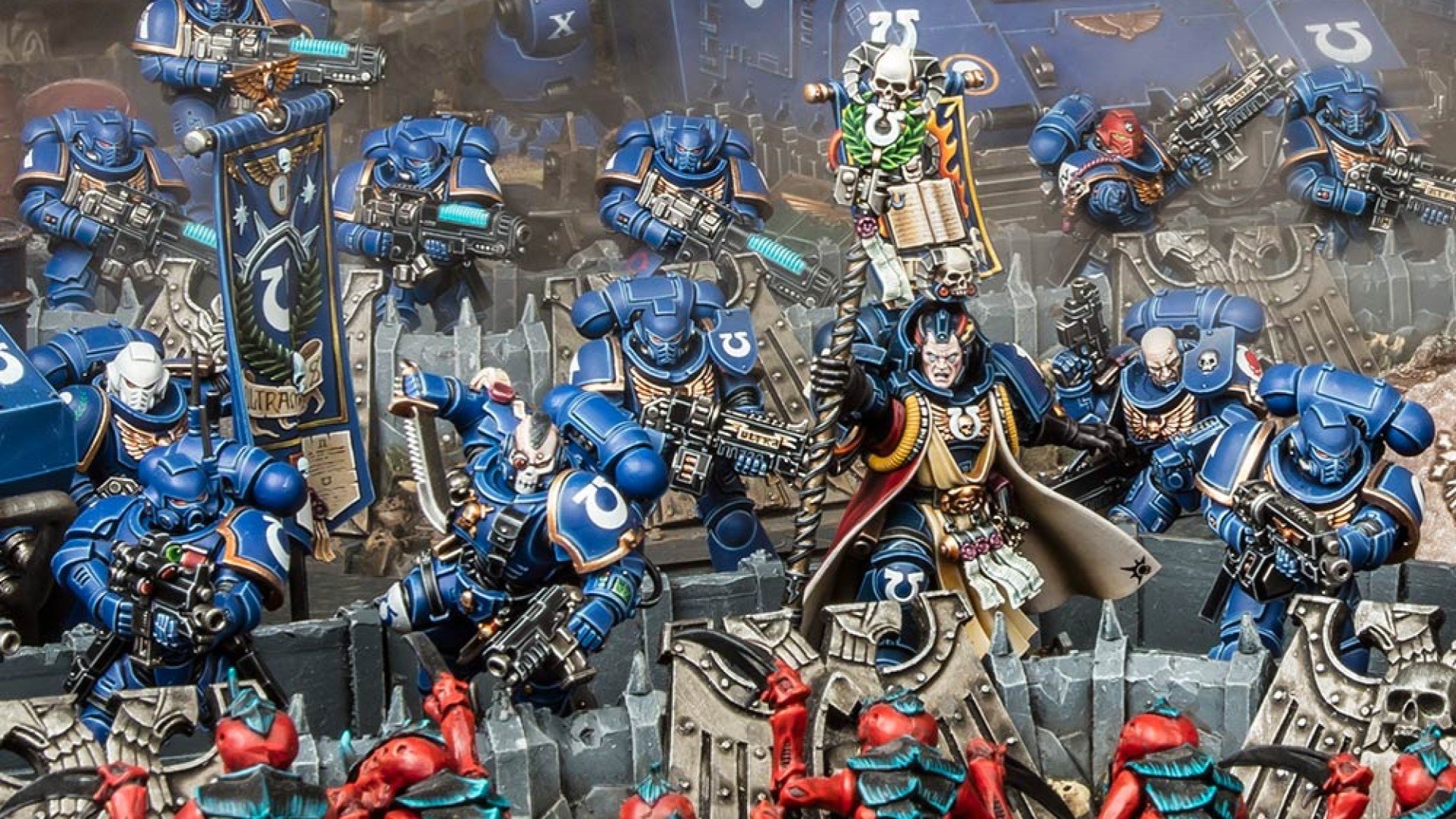
Books you need to play Ultramarines
You can discover more Ultramarines lore in the ninth edition Codex Space Marines, plus the eighth edition Codex Ultramarines supplement.
Salamanders
The XVIII Legion Astartes, and a proud and resilient First Founding Chapter, the green-armored Salamanders are a rather distinctive lot, for a few different reasons.
Native to the volcano-covered Death World of Nocturne, and based in a fortress monastery on its moon, Prometheus, the Salamanders favour fire and flamer-type weapons, above all other chapters – as evidenced on the tabletop by their unique Flamecraft and The Fires of Battle stratagems.
In Warhammer 40k lore, the Salamanders, like their lost Primarch, Vulkan, are also uniquely concerned with the welfare of the Imperium’s human citizenry, capable of stubbornly refusing to cooperate with a battle plan if it involves severe collateral damage to civilian populations.

In another questionable analogue to real-world human ethnicities, the Salamanders are also notable for their stone-hard, obsidian-black skin. Canonically, it’s caused by one of the Space Marines’ implanted extra organs, the Melanochrome, which causes their skin to change its colour and structure to protect against radiation-rich environments, in the same way humans’ skin evolved over millennia to be darker-coloured in sunnier climates – only orders of magnitude faster.
They’re pointedly not officially related to Earth’s black-skinned African ethnicities in any way – and yet, mysteriously, many Salamander characters in GW’s Black Library audiobooks are voiced with recognisable, yet non-specific African accents. More than anything, the Salamanders’ lore and real-world connections just seem disappointingly confused, and feel like a missed opportunity for Black African representation.
Like various aspects of Warhammer 40k lore, this topic has sparked many unpleasant, and often very stupid, debates among fans. The bottom line is that the Salamanders make sense in-universe, but – like the White Scars, Space Wolves, and Sisters of Battle, among others – they’re evidence that Warhammer’s narrative roots were planted in a time when haphazard, ill-considered fictional representations of women and people of colour were commonplace. It’s not a reason to cancel them, just important context – and a valuable reminder of Warhammer’s golden rule: don’t be a dick.
Once you’ve squared that away, there’s loads to love about this army. With a Chapter Tactic and special rules themed around reliable, high-quality weaponry, they tend to be one of the more competitive Space Marine armies, too – check out our guide to Salamanders for some suggestions.
Oh, and Vulkan lives!
Books you need to play Salamanders
You can find more Salamanders lore in the ninth edition Codex Space Marines, plus the eighth edition Codex Salamanders supplement.
Raven Guard
The XIX Legion Astartes, now the Raven Guard chapter, hold the triple distinctions of being the most ’emo’ Space Marine chapter; the stealthiest Space Marines; and the ones with the silliest names.
Their Primarch’s name, Corvus Corax, is literally the real-world Latin species designation for the common raven (and, individually, both those Latin words also mean ‘raven’). His chapter’s fortress monastery, on their homeworld of Deliverance, is called the Ravenspire. It’s serious overkill.
Still, with that out of the way, these alabaster-skinned, jet-black-haired Space Marines have a noble history of service to the Imperium – cruelly interrupted, like that of the Iron Hands and Salamanders, by being very nearly exterminated in the Istvaan V massacre.
The Raven Guard survived, however, and thrived, cultivating a name for themselves as silent, efficient killers, adept at achieving perfect positioning, before descending upon the foe from above to deal out sudden, sharp-bladed death. Codex Compliant, the Raven Guard boast a respectable family of successor chapters, including – most likely – the well-loved, shark-fancying Carcharodons chapter.

In the 41st millennium, the Raven Guard are led by Chapter Master Kayvaan Shrike, who recently crossed the Rubicon Primaris, changing from a Firstborn marine into a Primaris Space Marine, and getting a gloriously moody new miniature in the process.
Books you need to play Raven Guard
You can find more Raven Guard lore in the ninth edition Codex Space Marines, plus the eighth edition Codex Raven Guard supplement.
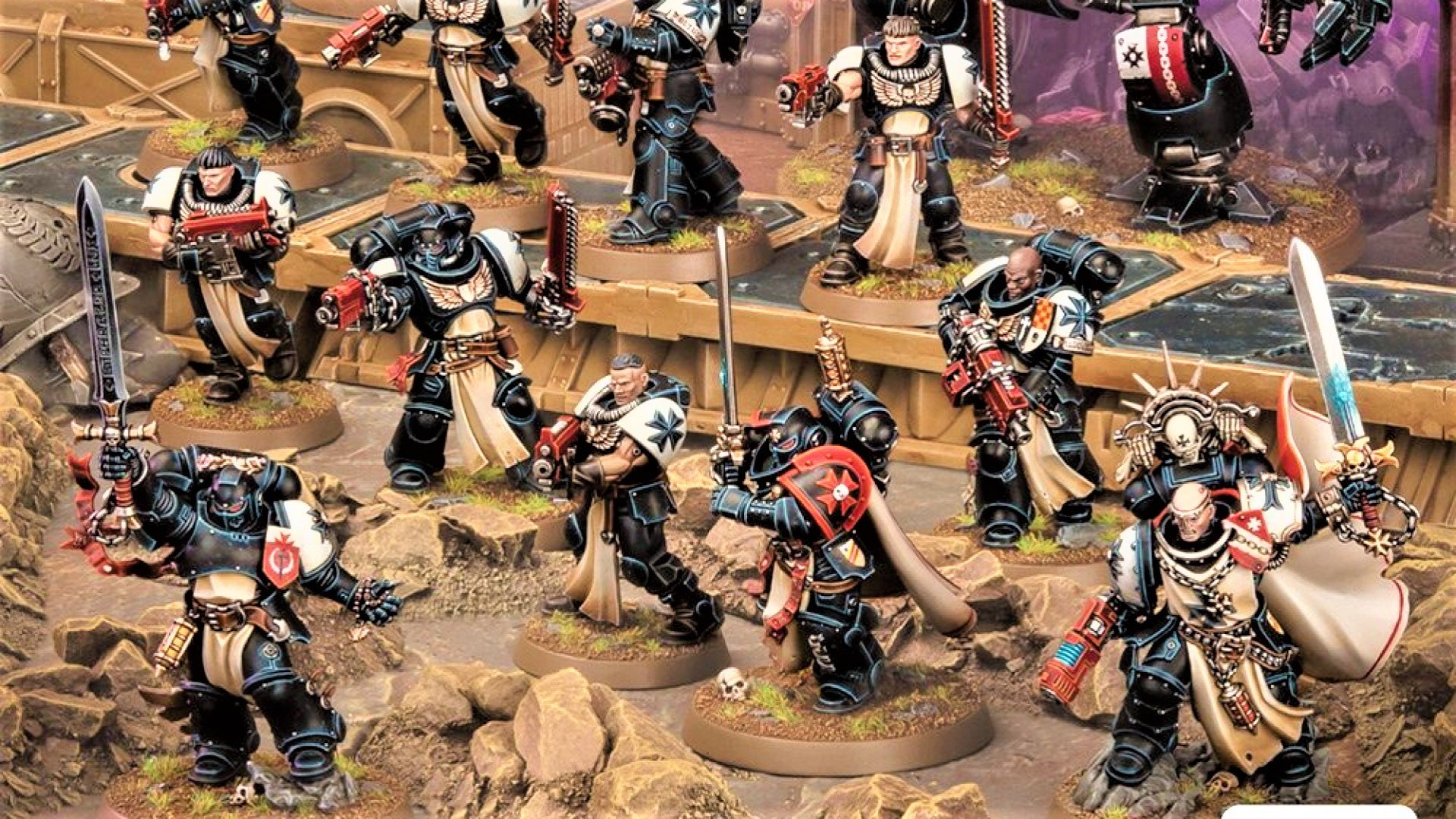
Space Marines successor chapters
In Warhammer 40k lore, there are many hundreds of known Space Marine successor chapters, so we couldn’t possibly cover them all – but there are a handful which have carved out more of a name for themselves than most – so we’ll tell you a little bit about those trailblazers.
What’s more, there are a number of Space Marine armies that stand apart from the main chapter structure – if you’re interested in the silver-armored, psychic, daemon-hunting Knights of Titan, check out our full guide to the Grey Knights.
If you lean more towards black-clad, alien-busting special ops Kill Teams, you’ll want to peruse our Warhammer 40k Deathwatch guide.
And if (like famous fan of Warhammer Henry Cavill) you feel drawn toward the golden light and preternatural fighting skills of the Emperor’s chosen bodyguards – check out our guide to the Adeptus Custodes.
In the meantime, though, let’s meet the:

Black Templars
By far the largest and most storied Successor Chapter out there, the zealous, crusading Black Templars, more than any other Space Marine Chapter, the angry, vengeful, hate-fueled, religious fury at the heart of the Imperium of Man in the 41st millennium.
Though they were founded from the dour, reserved Imperial Fists, and are created from the very same geneseed – that of Rogal Dorn – the Templars personify that noble Primarch’s permanently subdued rage, unleashed, and focused through the refining prism of dogmatic belief in the Emperor’s divinity, to produce an unrivalled destructive force, powered by faith and fury.
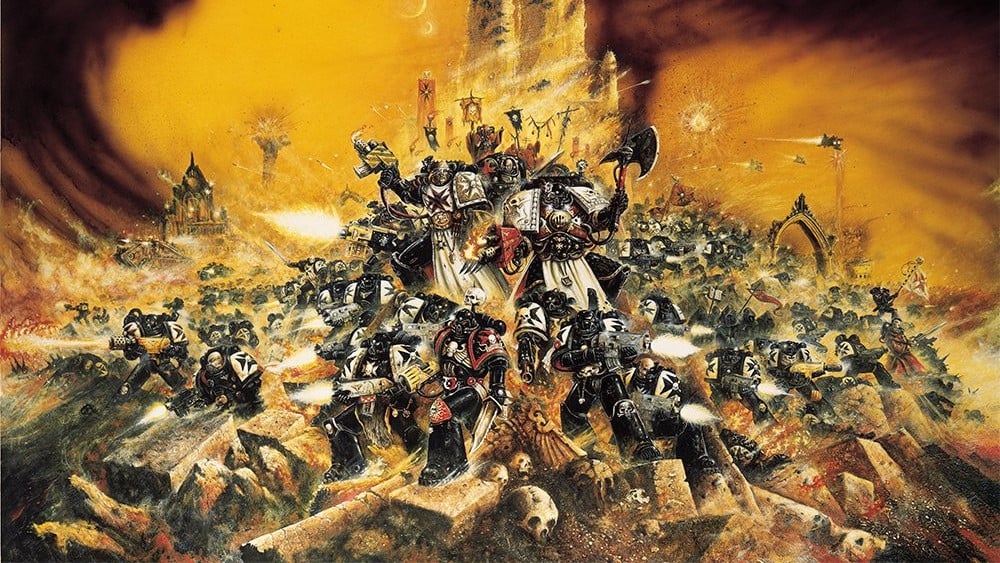
The Black Templars don’t even come close to following the Codex Astartes, recruiting new Space Marines as widely as possible, and conducting vast, endless, thousands-strong crusades against the Imperium’s many enemies in all kinds of far-flung corners of the galaxy.
We’ll have a fully-fledged guide on the Black Templars soon, but for now, check out our coverage of the 2021 Black Templars army set, featuring a new Black Templars codex, and a bunch of brand new models for the Chapter.
Books you need to play Black Templars
Black Templars use datasheets from Index Space Marines and Index Black Templars, both of which you can download from the Warhammer Community website.
You can discover more Black Templars lore in the ninth edition Codex Space Marines, plus the ninth edition Codex Black Templars supplement.
Combat Patrol Black Templars
The Combat Patrol: Black Templars box set contains:
- Primaris Crusader Squad containing five initiates, four neophytes and a Sword Brother
- Primaris Intercessors x 5
- Primaris Impulsor
- Primaris Marshal
- Black Templars Primaris upgrade sprue
Crimson Fists
If the Crimson Fists Space Marines were a word, that word would be: ‘indomitable’. A less kind word might be ‘inflexible’.
Another successor chapter of Rogal Dorn’s Imperial Fists, their entire forces, fortress monastery, and home planet of Rynn’s World were almost entirely wiped out by an Ork Waaagh! from which they refused to retreat – but the chapter survived, by skin of its teeth, and by the legendary, unstinting courage of their Chapter Master Pedro Kantor, with just a few Space Marines left.
Since then, despite their minimal numbers, and the devastation of their home region of space, the Crimson Fists have dutifully followed the Codex Astartes, and built a martial reputation around their knack for stubbornly holding ground. Even their tabletop Chapter Tactic reflects it: appropriately titled No Matter The Odds, it grants Crimson Fists models a bonus to hit, if they’re shooting at a unit with at least five more models in it than the shooter’s own. Worth choosing if you like to make a stand.
Books you need to play Crimson Fists
You can find more Crimson Fists lore in the ninth edition Codex Space Marines, plus the eighth edition Codex Imperial Fists supplement.
Flesh Tearers
The Blood Angels’ most famous Successor Chapter, the Flesh Tearers, have a well-deserved reputation for ferocious bloodlust (the clue’s in the name). Shunned by their parent chapter and the other Successors for their uncommon, occasionally uncontrolled brutality in battle, the Flesh Tearers have come close to being excommunicated from the Imperium and designated Renegades, but have always been exonerated as loyal – though just barely.
With their strain of their Primarch’s geneseed especially prone to Sanguinius’ genetic faults, more Flesh Tearers succumb to the Black Rage and Red Thirst than any other Blood Angels Successors – adding to their reputation for unchained slaughter, and suspicions of Chaos corruption.
Their Chapter Master, Gabriel Seth, mitigates the worst of this by committing his troops as vanguard forces right into the thick of every assault, hoping to sate their desire for bloodletting, and minimise chances of the Flesh Tearers losing control and tearing into their own allies.
The arrival of Primaris Space Marine reinforcements has also reportedly been a stabilising influence, as they appear more resilient to the pitfalls of Sanguinius’ infamous genetic ‘Flaw’ – though Gabriel Seth has a nasty habit of headbutting the pretty out of them until they look like proper Flesh Tearers
Books you need to play Flesh Tearers
The Flesh Tearers use Index Space Marines and Index Blood Angels, which you can download for free from the Warhammer Community website.
You can find more Flesh Tearers lore in the ninth edition Codex Blood Angels supplement.
If you like the sound of these power-armored super-warriors, but don’t feel like painting miniatures, keep an eye on our Space Marine 2 release date guide – we’re tracking everything we can find out about the upcoming third person action game.
With thanks to Ramanan Sivaranjan for his photo of the Crimson Fists diorama at Warhammer World, and Nerodine for his Ultramarines Lieutenant Calsius and his Space Wolves Grey Hunters.
